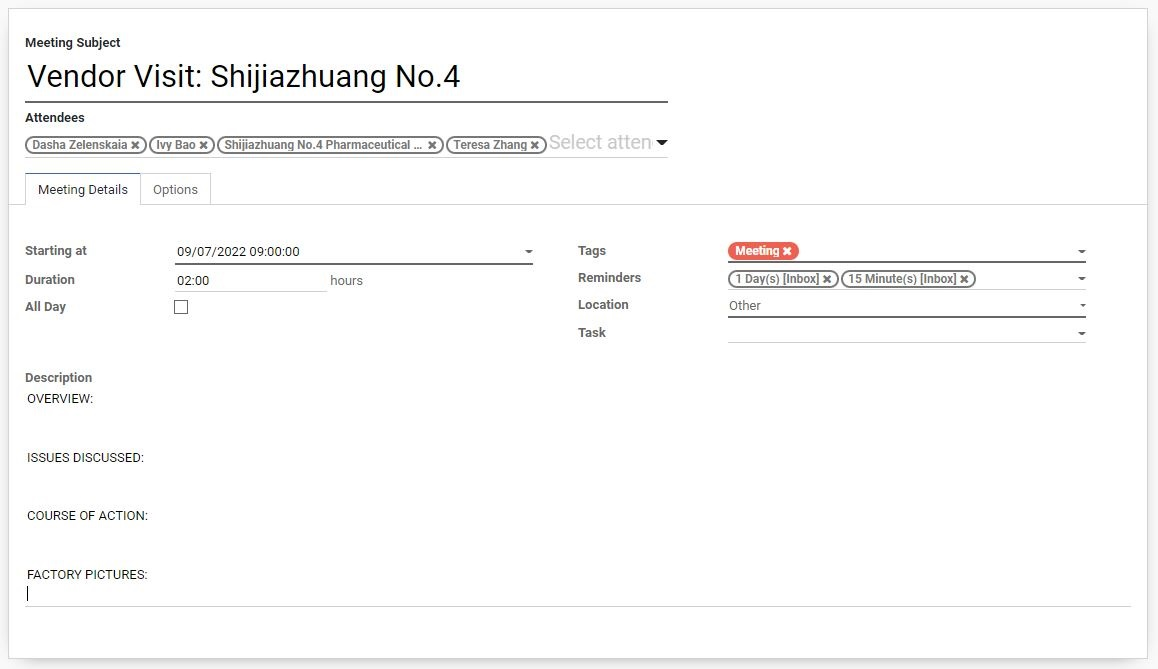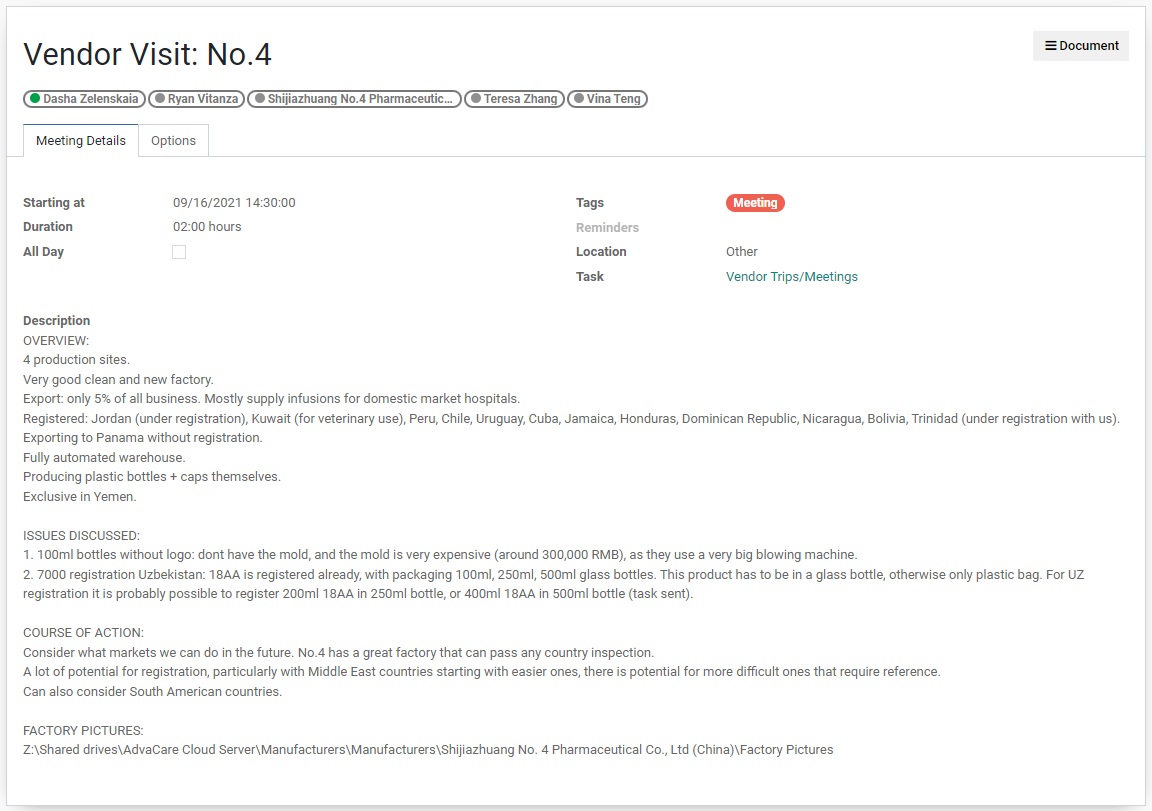Vendor Meetings/Trips
| 5 minutesVendor Meetings can refer to:
- Vendor office meetings - when Vendor visits AdvaCare offices;
- Vendor visits/trips - when Purchasing Dept. visits Vendor office or manufacturing sites.
Every meeting needs to have a clear agenda and follow a certain process that is aimed to have clear results achieved from the meeting. If there is no agenda and no results achieved, any meeting can be considered a waste of time. Meetings with Vendors are useful not only to maintain or establish relationship with the Vendor, but more so to collect information that can be used in ongoing orders/RFQs/registrations or for potential business development with a Vendor.
Every meeting has 3 stages: preparation, actual meeting, and applying the information collected after the meeting. This SOP explains the steps of how to successfully prepare for the meeting, how to hold the meeting, and what to do after the meeting.
Preparation for the meeting
Preparation for the meeting might vary slightly depending on Vendor - whether the meeting is with a new Vendor or existing Vendor which AdvaCare works with on continuous basis.
- Once the meeting date and time are identified, Purchasing Person must create an Event in Calendar in the System, and add all the attendees into the Event. Purchasing Person must add the Vendor to the attendees of the Calendar Event to connect the Meeting with the Vendor page in the System. The Event Description must be filled out according to the template given below.
- Once the meeting is scheduled, Purchasing Person needs to collect all the relevant information for the meeting in order to prepare the questions for the Vendor. Preparation has to start at least a week in advance if possible, or several days in advance if the meeting is scheduled to be sooner.
- If the meeting is with the new Vendor, check all the information already available about the Vendor in the System or File Server. If the information in the System is missing, one of the main purposes of the meeting is to collect the relevant information to be able to fill out the System accordingly.
- Consider the ongoing RFQ/Registration/Order which might apply to the Vendor. Each Purchaser has to go through the list of ongoing RFQ/Registration/Order assigned to them, and then collect the information from all members of Sales Dept. by sending a message in the Meeting chatter in Calendar addressed to all Sales Dept. members and Purchasing Dept. Manager.
- Prepare Purchasing Meeting Itinerary Template and fill it out according to the available information, and add the questions related to ongoing RFQ/Registration/Order in the Itinerary. The Itinerary Template is saved in the file server: Z:\Shared drives\AdvaCare Cloud Server\Templates\Business Templates\Other Agreements & Letters\Itinerary
- The filled out Itinerary must be saved in the Vendor folder in File Server.
- Every Purchaser must go through the above Itinerary and add questions, after it is filled out by each Purchasing Person, Purchasing Dept. Manager will check and revise if necessary.
- Once the Itinerary is final, print it out in several copies (one for each Attendee) with Vendor name on top.
Calendar Event Template (for the Meeting in Calendar):
OVERVIEW:
ISSUES DISCUSSED:
COURSE OF ACTION:
FACTORY PICTURES:
Below is the example of the correct Event set up with Description:

During the meeting
Each Purchasing Person is to go through the itinerary during the Meeting, ask every question on the Itinerary and TAKE NOTES of the answers. Everything discussed has to be recorded in the notes of each Purchasing Person.
After the meeting
After the meeting, Purchasing Dept. has to record everything discussed in the system and make sure relevant actions for each specific RFQ/Order/Registration are taken.
- Meeting Report needs to be filled out inside the Description of the Calendar Event of the meeting. Each part of the Description needs to be filled out according to issues discussed and each Attendee must add to the Description.
- COURSE OF ACTION needs to be decided: the steps that need to be taken after the meeting for each RFQ/Order/Registration and/or general direction for the future cooperation with the Vendor.
- All the new information must be filled out in Vendor page in the System.
- Once all the information is filled out in Event Description and under Vendor page, task to Sales Dept. must be sent under Event chatter to all members of Sales Dept. to read Event Description.
- Actions defined in COURSE OF ACTION must be taken by each responsible member of Purchasing Dept. with relevant tasks sent under each RFQ/Order/Registration or other parts of the System.
- If one member of Purchasing Dept. didn't attend the meeting with the Vendor for any reason, Purchasing Dept. needs to have a short meeting to exchange the information inside the department.
Below is the example of the final filled out Event Description after the Meeting:

Vendor Trips
When Purchasing Dept. intends to visit a manufacturing site of certain Vendors, not only it is required to prepare for the meeting, but also to properly plan and schedule the trip.
Preparation for the trip
The trip has to be planned out in advance. Once the destination is determined (for example, Shijiazhuang), Purchasing Person responsible for Trip preparation needs to follow the process below:
- Find all the Vendors located at the chosen destination or at reachable distance to chosen destination (all Vendors familiar to AdvaCare). To find the Vendors Purchasing Person must look through all the folders of manufacturers in the file server and search by relative province in the ERP.
- Send a task to Purchasing Dept. Manager with the list of Vendors located at the chosen destination or at reachable distance to chosen destination.
- Define the best route to the destination: train, airplane, other.
- Once Purchasing Dept. Manager decides which Vendors to visit, check the distance between Vendors, possible ways of transportation between Vendors, and from train station/airport to the Vendors.
- Based on the distance, decide the most time efficient itinerary (which Vendor to visit first, second, third, etc.).
- Check with Vendors whether the date is acceptable, whether relative workshops can be visited during the trip and whether Vendor Managers or CEOs are available during the trip dates.
- Check with Vendors whether they can arrange for pick up at the train station or airport and assist with further transportation if required.
- If the trips requires overnight stay, look for suitable area or district that makes most sense from time efficiency perspective.
- Once the best itinerary is defined, inform Purchasing Dept. Manager.
- Purchasing Dept. Manager will inform Office Manager Assistant to book the flights/train tickets/hotels.
- Purchasing Person must prepare an Itinerary document which will include the time schedule of the whole trip (each Vendor meeting scheduled for certain time, the length of each meeting, time spent on the way, etc.). Purchasing Person must then print out the Itinerary for every attendee of the trip.
During the trip
Purchasing Person must coordinate the transportation between the Vendors, strictly follow the schedule and control the length of each meeting. During the meetings Purchasing Person must take notes of everything discussed.
After the trip
After the trip the same process as after any meeting must be followed.